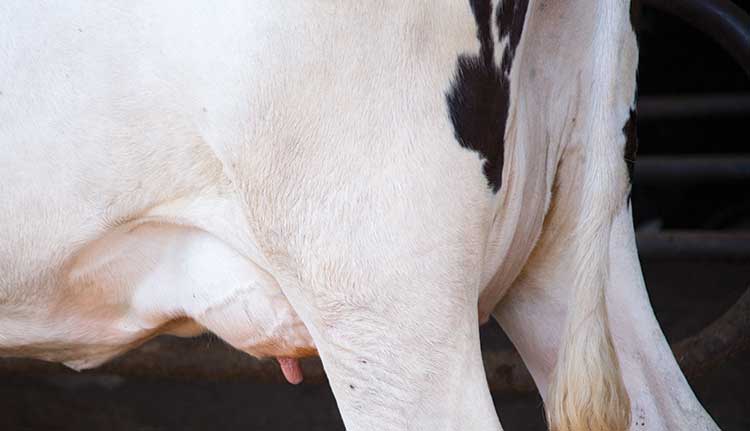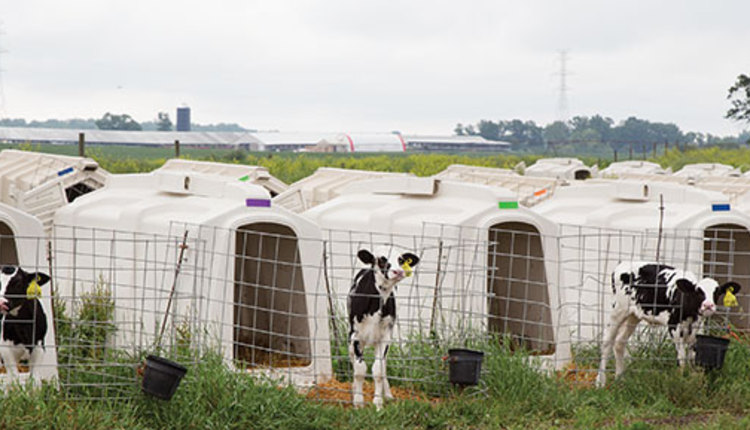The author received his Ph.D. at Virginia Tech in lactation physiology and dairy calf nutrition. He was formerly with Milk Products Inc.

You’ve heard it before: calves fed a higher plane of nutrition make more milk in the first lactation. But how does it happen?
In the previous article of this series, it was made clear that by feeding calves better, more functional tissue is present in the mammary gland at weaning. Yet, we also know that the composition of that tissue is quite similar to the tissue of calves that are not fed a higher plane of nutrition.
Is this difference in functional tissue mass responsible for differences in observed future milk yield? It is quite possible! But why is more functional tissue present in calves at weaning when we feed them a higher plane of nutrition early in life? Answering that question is the goal of this article.
Estrogen plays a role
The mammary gland develops in response to hormones and growth factors. One key hormone in this process is estrogen. Without the influence of estrogen in early life, the mammary gland of the calf will not develop. What if, by feeding calves more, we are “priming” the mammary gland to better respond to estrogen and/or other stimuli? What if that priming is behind observed changes in functional tissue mass at weaning? That hypothesis will serve as the basis for this article.
If added efficiency of estrogen utilization is truly at play in calves fed better, it makes sense for us to look at the estrogen receptor in the mammary gland parenchyma (functional tissue). When estrogen attaches to its receptor in the mammary gland, a cascade of signaling events occur, resulting in mammary gland development and proliferation, which may lead to more efficient use of estrogen by the mammary gland.
When looking at the mammary parenchyma in careful detail, there were no differences in the number of cells that express (or have) the estrogen receptor. This indicates there are not more cells able to utilize estrogen in the mammary gland of calves fed a higher plane of nutrition.
Next, we decided to look at the intensity of expression of the estrogen receptor in the mammary gland. Elevated intensity of estrogen receptor expression can indicate a lot of things, including that there are more estrogen receptors on each positive cell. This would mean that although there are not more cells with estrogen receptors in the mammary gland, the cells that do have estrogen receptors may have more than one.
Measuring estrogen receptor expression intensity is a very new technique. When calves are fed a higher plane of nutrition, estrogen receptor expression intensity is nearly doubled. This may indicate that calves fed a higher plane of nutrition have mammary cells that can respond more efficiently to estrogen. This was the first study to indicate this.
Since estrogen plays a role in cell proliferation, it would be anticipated that this elevation in estrogen receptor expression intensity may lead to an increase in cellular proliferation, which would then help explain the increase in functional tissue mass observed when calves are fed a higher plane of nutrition.
The number of cells actively dividing in the mammary parenchyma rose from 10 percent in the control calves to 15 percent in the calves fed a higher plane of nutrition. When the area of the mammary parenchyma that was actively dividing into the mammary fat pad was assessed (see article one in the series), the number of cells actively dividing was almost doubled in calves fed a higher plane of nutrition.
What does this tell us? From what we have seen so far, it may be that when we feed calves better, the functional tissue in the mammary gland is able to utilize estrogen more efficiently, resulting in enhanced cellular proliferation in the mammary gland. This increase in proliferation results in a greater mass of functional tissue in the developing mammary gland.
In the first article of this series, it was discussed that the mammary gland is still developing after birth. Because of this fact, we may be able to have a “fetal programming-like” effect on the mammary gland after the calf is born. For this effect to occur, we would anticipate that by feeding a higher plane of nutrition, changes would occur on the gene level that shift the calf into a state that encourages enhanced mammary development.
Looking at the genes and gene pathways impacted by feeding a higher plane of nutrition yields interesting results. When we feed calves better, we are influencing the expression of over 1,500 genes within the functional tissue of the mammary gland. These genes are related to things such as nutrient metabolism and absorption, steroid hormone biosynthesis, immune function, and cellular proliferation.
Perhaps by feeding calves better at a young age, we are creating a physiological shift in early life that is telling the calf to spend more energy on cellular proliferation and nutrient absorption/metabolism in the mammary gland. This may set the stage for much greater mammary mass and the ability to produce and secrete more milk in the future.
Why does this matter?
Let’s circle back to the initial hypothesis of this article: Does feeding calves better allow the mammary gland to more actively respond to estrogen? We gave estrogen to the same calves discussed in this series to see if it did. When we did that, functional tissue mass was increased well beyond that of any of the other calves on the trial. A similar rise in mass was not found when we gave calves fed the 20-20 milk replacer an estrogen dose.
Even further, complexity of mammary development was significantly altered, and cellular proliferation levels rose well beyond anything seen in previously published research. Granted, the amount of estrogen given to these calves was not “biologically normal,” but the fact that estrogen impacted calves fed a higher plane of nutrition to a greater extent than control calves may indicate that these calves had the capacity to respond more efficiently.
What does this all mean to you? Why did we go into detail about the mammary gland and how it is impacted by calf feeding during the preweaning period?
The industry as a whole is shifting toward feeding a higher plane of nutrition to young dairy heifers. Not everyone is offering unlimited milk, but certainly more and more producers are upping milk allowances for their calves.
You may be asking if this is right for you. If you are, and if you have read the data that indicates feeding calves better will give you more milk down the road, the hope is that this series of articles will help make you more comfortable with making that decision.
An enhanced feeding regimen is not for every operation, nor should it be. But, if this series of articles and the data presented within has shown you anything, hopefully it has indicated that feeding calves better can have an incredible impact on the calf and her mammary gland. It is also clear as we investigate this area more, that if we invest in our calves, they will return the favor in the years to come.
First issue: Feed now and reap the rewards later
Second issue: We can influence mammary growth










